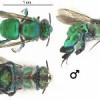 Green orchid bees are a quite conspicuous and charismatic species. This is mostly due to their large size and bright metallic-green coloration. They are very fast and agile flyers, and can be seen quickly darting from flower to flower separated by long periods of hovering. Male orchid bees collect fragrant volatile compounds from their environment and present them to females by fanning their wings and “spray ventilating” their bouquet for the inspection of prospective mates. In Florida, male green orchid bees are attracted to chemicals produced by certain wood-rot fungi, decomposing vegetation, perfume flowers, and certain essential oils such as clove and cinnamon oil. Male green orchid bees can be quickly and easily attracted and observed by soaking a small piece of paper with clove oil and placing it outside. This 4-page fact sheet was written by Aaron Mullins, and published by the UF Department of Entomology and Nematology, October 2013.
Green orchid bees are a quite conspicuous and charismatic species. This is mostly due to their large size and bright metallic-green coloration. They are very fast and agile flyers, and can be seen quickly darting from flower to flower separated by long periods of hovering. Male orchid bees collect fragrant volatile compounds from their environment and present them to females by fanning their wings and “spray ventilating” their bouquet for the inspection of prospective mates. In Florida, male green orchid bees are attracted to chemicals produced by certain wood-rot fungi, decomposing vegetation, perfume flowers, and certain essential oils such as clove and cinnamon oil. Male green orchid bees can be quickly and easily attracted and observed by soaking a small piece of paper with clove oil and placing it outside. This 4-page fact sheet was written by Aaron Mullins, and published by the UF Department of Entomology and Nematology, October 2013.
http://edis.ifas.ufl.edu/in1013
Tag: Family: Apidae
Cape Honey Bee Apis mellifera capensis Escholtz (EENY513/IN916)
 Cape honey bees can produce both male and female offspring parthenogenetically. Unlike other African bee races, they are docile, but unlike all other races of honey bees, they are social parasites. Find out why South African beekeepers consider Cape bees a more serious threat than the varroa mite in this 4-page fact sheet was written by James D. Ellis, and published by the UF Department of Entomology and Nematology, December 2011.
Cape honey bees can produce both male and female offspring parthenogenetically. Unlike other African bee races, they are docile, but unlike all other races of honey bees, they are social parasites. Find out why South African beekeepers consider Cape bees a more serious threat than the varroa mite in this 4-page fact sheet was written by James D. Ellis, and published by the UF Department of Entomology and Nematology, December 2011.
http://edis.ifas.ufl.edu/in916
The Bumble Bees of Florida, Bombus spp. (EENY050/IN207)
 Bumble bees are easily recognized by the corbicula (pollen basket) on the hind tibiae in the females. They are beneficial insects that pollinate many native and ornamental plants. They can sting severely, so problem nests near human dwellings should be removed by experienced pest control operators. This 5-page fact sheet includes a key to the bumble bees in Florida. Written by Lionel A. Stange, and published by the UF Department of Entomology and Nematology, December 2011.
Bumble bees are easily recognized by the corbicula (pollen basket) on the hind tibiae in the females. They are beneficial insects that pollinate many native and ornamental plants. They can sting severely, so problem nests near human dwellings should be removed by experienced pest control operators. This 5-page fact sheet includes a key to the bumble bees in Florida. Written by Lionel A. Stange, and published by the UF Department of Entomology and Nematology, December 2011.
http://edis.ifas.ufl.edu/in207
EENY429/IN790 African Honey Bee, Africanized Honey Bee, Killer Bee, Apis mellifera scutellata Lepeletier (Insecta: Hymenoptera: Apidea)
EENY-429, a 7-page illustrated fact sheet by James D. Ellis and Amanda Ellis, is part of the Featured Creatures collection. It describes a subspecies of western honey bee occuring naturally in sub-Saharan Africa that has been introduced into the Americas — distribution, description, life cycle and biology, public risks, economic impact, and management. Includes selected references. Published by the UF Department of Entomology and Nematology, February 2009.
http://edis.ifas.ufl.edu/IN790